Why you can trust TechRadar

The UE40D6530 achieves its slimness by employing an edge-LED backlight. This is well implemented; there's some light pooling but Samsung manages illumination uniformity well.
To help grade its own TV range, Samsung has developed a proprietary motion resolution and image quality system called CMR (Clear Motion rate). You'll see it mentioned on point-of-sale from the brand. Samsung rates the UE40D6530 as 400 CMR – but how does that compare with our real world tests? Let's take a closer look.
Samsung's fast frame rate technology is Motion Plus, and it comes in several iterations: Clear, Standard, Smooth and Custom. Naturally, you can also elect to switch it off. If you do disengage it, the perceived native motion resolution of the panel comes in at around 875 lines, which is not too shabby.
Engage any of the Motion Plus modes and this figure jumps to a full 1,080 lines. This was confirmed by a horizontal scrolling test pattern developed by the Advanced PDP Development Centre; the pattern features ever-decreasing fine detail patterns, and moves at variable speeds from 6.5ppf (pixels per frame).
Of the preset modes, Clear is the best option available. All the others generate motion artefacts, seen around certain moving objects as a smudgy, shadowy outline. Clear does cause some artefacting but it's hardly noticeable. Our tip though is to select the custom menu and then set Blur Reduction at 7 and Judder reduction at 0; this way you'll maximise moving resolution and eliminate artefacts altogether.
The black levels are very good. The UE40D6530 tracked in a 20/20 step grayscale beautifully, giving convincing blacks and ample shadow detail. One key characteristic of the UE40D6530 is its absolute lack of noise. Images have an almost photographic smoothness.
Test Blu-ray footage shot around the Tokyo Tower at night proved hugely impressive. While the night sky is rendered espresso-black, detail remains evident in the shadows while bright lights ping dynamically - a great performance. On some rival LED sets, this challenging dark sequence is peppered with intrusive luminance noise that's difficult to minimise.
Sign up for breaking news, reviews, opinion, top tech deals, and more.
On a challenging movie such as Tron: Legacy (Blu-ray) these traits translate to a picture which has genuine depth and popcorn-tastic impact.
While the UE40D6530 is an excellent 2D TV, its three dimensional talents are more routine. 3D images exhibit unavoidable crosstalk. While the TV proffers controls to combat this, in the form of 3D Perspective and 3D Optimisation sliders, neither solve the problem of double imaging.
If you dial crosstalk out of the negative parallax plane it's merely emphasised on the zero parallax plane, and vice versa. There's no happy balance where it's not noticeable.
The impact this will have on your viewing is to a certain extent dependant on the 3D quality of your software. A troublesome disc such as Monsters Vs Aliens looks pretty unpleasant; however well-authored fare such as Tron: Legacy and Avatar are passable enough.
On the plus side, the sense of depth the TV can give is undiminished and colour fidelity remains high, even when you don 3D glasses.
The UE40D6530 will also convert 2D to 3D, should you not have enough 3D to watch on Blu-ray or Sky. This signal processing is undeniably clever stuff, although the aforementioned presentational issues remain unchanged.
Current page: Samsung UE40D6350: Picture quality
Prev Page Samsung UE40D6350: Features Next Page Samsung UE40D6350: Sound, value and ease of use
Steve has been writing about AV and home cinema since the dawn of time, or more accurately, since the glory days of VHS and Betamax. He has strong opinions on the latest TV technology, Hi-Fi and Blu-ray/media players, and likes nothing better than to crank up his ludicrously powerful home theatre system to binge-watch TV shows.
